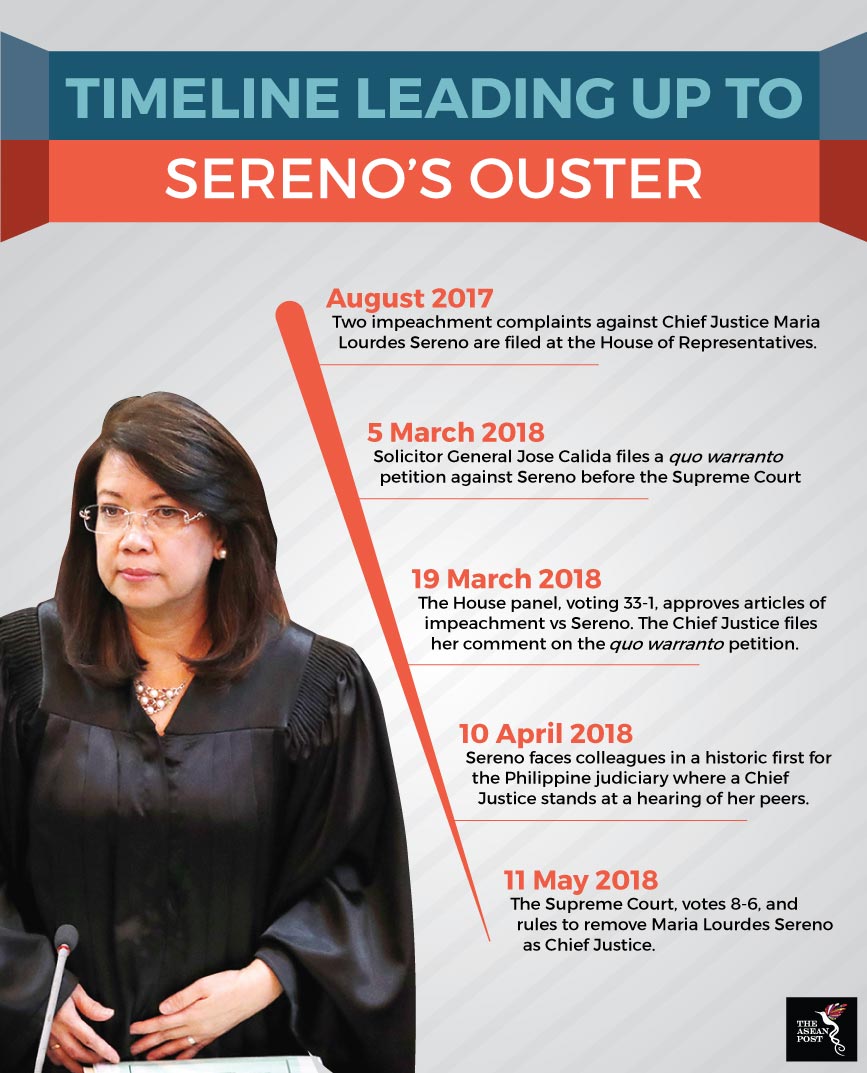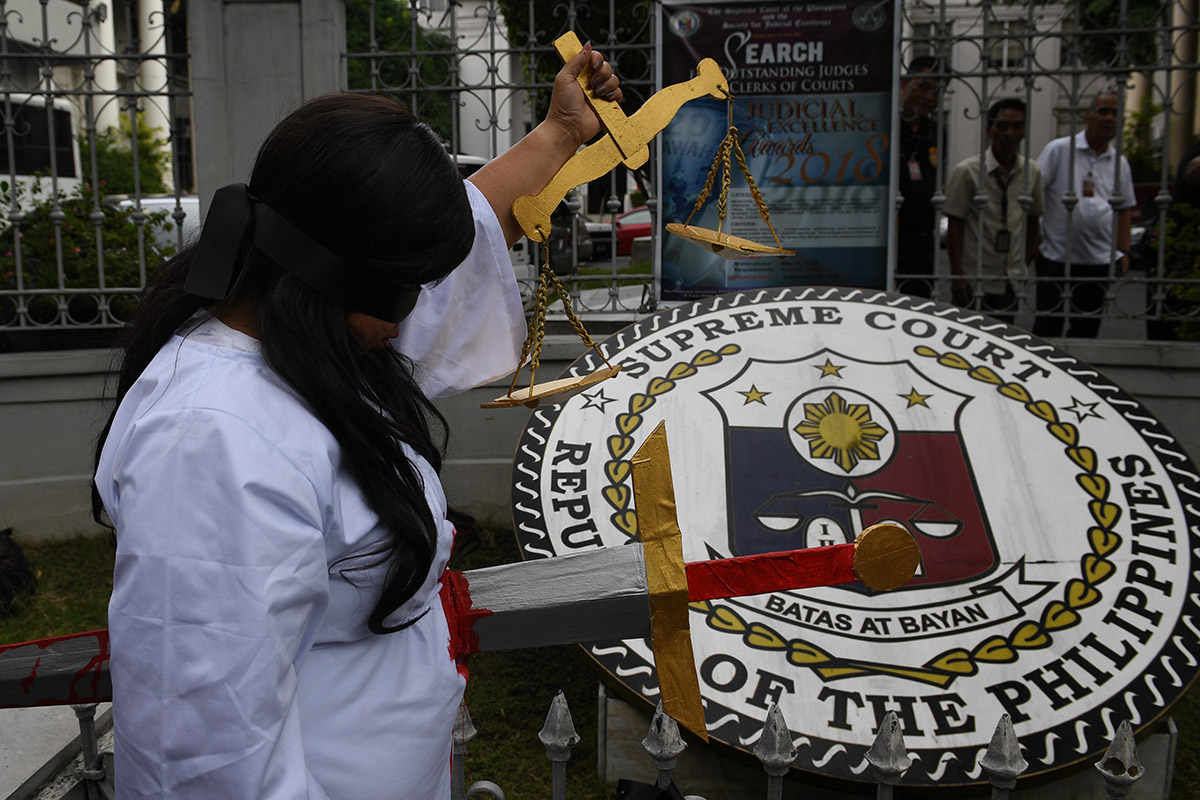The Supreme Court of the Philippines ruled on Friday to remove Maria Lourdes Sereno as Chief Justice. The historic ruling was made in a special en banc session which saw the high tribunal ultimately vote 8-6 against Sereno and declare void her appointment as the country’s Chief Justice.
The ruling is immediately executory but Sereno is expected to file an appeal against the decision. Her team of lawyers have confirmed that they are studying possible grounds for the appeal.
The decision was condemned by Philippine lawyers, lawmakers and civil society alike. Sereno has been a vocal critic of President Rodrigo Duterte’s vicious war on drugs which has resulted in the deaths of thousands of Philippine civilians. She also spoke out against Duterte’s extension of martial law in Mindanao last year.
Diminishing of democracy
Sereno was an appointee of the previous administration under Benigno Aquino III. The Philippines’ constitution does not accord a term limit for the chief justice, but he or she is generally obliged to retire upon reaching the age of 70. She was also the first woman and second youngest person to assume the position.
Duterte, who has a penchant for silencing his critics, was accused of executive overreach in orchestrating the ouster of Sereno. However, his office unequivocally denies such claims.
Since assuming the office of the President in 2016, Duterte has incessantly pursued his detractors – from parliamentarians, to civil society icons and media organisations. In April, he called Sereno an “enemy” and said that he would accelerate her removal from the Supreme Court.
In a statement, the Philippine Commission on Human Rights expressed their “disbelief” at the ruling and “denounced” the decision altogether.
“This decision has diminished our democracy. It erodes our obedience to the rule of law and departs from the will of the Filipino people,” the statement read.
It also condemned the method of removal as “unsanctioned” by the country’s constitution.

Source: Various sources
Sereno was ousted after the court granted a quo warranto petition which was filed by Solicitor General Jose Calida in March this year. The 34-page petition challenged the legality of Sereno’s appointment due to her failure to fully disclose her wealth and appealed to the court to have Sereno’s appointment as Chief Justice declared void.
However, many Philippine constitutional experts have pointed out that any sitting Chief Justice can only be removed through an impeachment, and a quo warranto petition cannot supplant that. The only Philippine Chief Justice to previously be impeached was Sereno’s predecessor, Renato Corona, who failed to publicly disclose his net worth.
Judicial integrity in question
Sereno is concurrently facing an impeachment complaint in the Philippine House of Representatives. In March, the House Justice Committee, voting 33-1, approved articles of impeachment against her. Her case is expected to be then elevated to a plenary session of the House. If it attains a one-third vote majority there, the case will then be transmitted to the Senate for an impeachment trial.
Filipino senator, Leila de Lima, who herself faced persecution for her vociferous stance against Duterte’s war on drugs, called the decision a “travesty of justice”.
In her statement, De Lima denounced the Supreme Court’s motives, attributing the move to a desire on its part to “rule through judicial tyranny”. She said that Duterte may now have a “partnership” with the judiciary but warned that “there can only be one absolute despot, and it will not be the justices of the Court.”
She further lambasted the justices, accusing them of conspiring to increase the Supreme Court’s power through the mechanism of Sereno’s ouster.
“Quite the contrary, they have just destroyed [the Supreme Court] together with the rest of the judiciary. Nothing will now stop Duterte from finishing off the rest of our democratic institutions,” she warned chillingly.
Sereno’s unceremonious removal sparks concerns over a possible constitutional crisis and an increasing grip by the executive on all branches of government. With Sereno out of the way, Duterte now has a free hand to appoint the next Chief Justice.
Going by the constitution, Duterte has 90 days from the date of vacancy to appoint a replacement from a list of nominees submitted by the Judicial and Bar Council (JBC). The nominees are normally selected from the existing Associate Justices, and those who make the cut are mostly senior justices.
In the court’s over 100-year history, only twice – in 1901 and 1921 – has there ever been a Chief Justice who hadn’t previously served as an Associate Justice. If Duterte wishes to cement his grip on the judiciary, he could select a benefactor from outside the current pool of Associate Justices to occupy that esteemed position.
However, he may very well pick one from within the current crop of justices who might be in favour of him. Senior Associate Justice Antonio T Carpio, who is currently serving as Acting Chief Justice was one of the eight justices who voted in favour of Sereno’s removal. He was appointed by Duterte last year and stands a bright chance of becoming the next Chief Justice of the Philippines.
